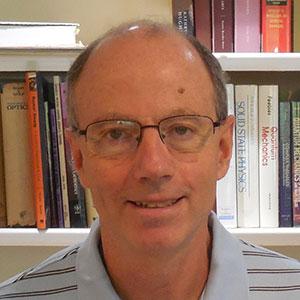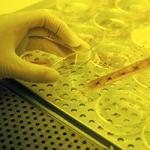
Research Topics
The purpose of our research is twofold: (1) to expand the capabilities of experimental techniques, especially solid state NMR techniques, for probing structural properties of molecules with central roles in biology and human disease; (2) to provide new structural and mechanistic information about specific biomolecular systems, including protein assemblies that are associated with Alzheimer’s disease, type 2 diabetes, and AIDS.
Current Research
My lab is currently pursuing several distinct but inter-related projects. We are using solid state NMR and electron microscopy to characterize molecular structures of amyloid-β fibrils, including fibrils that develop in brain tissue of Alzheimer’s disease patients. We are developing new experimental methods that allow detailed molecular structural studies of transient intermediates in processes such as protein folding, ligand binding, peptide aggregation, and protein self-assembly. We are investigating the structural and physical basis for fibril formation by low-complexity protein sequences. We are using solid state NMR and electron microscopy to characterize protein assemblies that mimic assemblies within HIV-1 and SARS-CoV-2 virions. And we are developing ultra-low-temperature methods for sensitivity enhancement in biomolecular solid state NMR and resolution enhancement in magnetic resonance imaging.
Biography
- Senior Investigator, LCP, NIDDK, NIH, 1994-present
- Member of Technical Staff (Principal Investigator), Physical Chemistry Research Department, AT&T Bell Laboratories, 1986-1994
- Postdoctoral Researcher, University of Pennsylvania, 1984-1986
- Ph.D., University of California at Berkeley, 1984
- A.B., Princeton University, 1980
- Fellow of the American Physical Society (1997), the American Association for the Advancement of Science (2005), the International Society of Magnetic Resonance (2008), and the American Academy of Arts and Sciences (2017). Member of the National Academy of Sciences (2020).
Selected Publications
- Wilson CB, Yau WM, Tycko R. Experimental Evidence for Millisecond-Timescale Structural Evolution Following the Microsecond-Timescale Folding of a Small Protein. Phys Rev Lett. 2024;132(4):048402.
- Lee M, Yau WM, Louis JM, Tycko R. Structures of brain-derived 42-residue amyloid-β fibril polymorphs with unusual molecular conformations and intermolecular interactions. Proc Natl Acad Sci U S A. 2023;120(11):e2218831120.
- Chen HY, Wilson CB, Tycko R. Enhanced spatial resolution in magnetic resonance imaging by dynamic nuclear polarization at 5 K. Proc Natl Acad Sci U S A. 2022;119(22):e2201644119.
- Jeon J, Yau WM, Tycko R. Millisecond Time-Resolved Solid-State NMR Reveals a Two-Stage Molecular Mechanism for Formation of Complexes between Calmodulin and a Target Peptide from Myosin Light Chain Kinase. J Am Chem Soc. 2020;142(50):21220-21232.
- Wilson CB, Lee M, Yau WM, Tycko R. Conformations of a low-complexity protein in homogeneous and phase-separated frozen solutions. Biophys J. 2024;123(23):4097-4114.
Related Scientific Focus Areas

Biomedical Engineering and Biophysics
View additional Principal Investigators in Biomedical Engineering and Biophysics


This page was last updated on Thursday, August 7, 2025